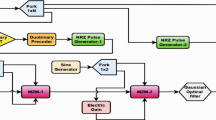Abstract
This article proposes an N-finite Radon transform (N-FRAT) and a discrete framelet transform (FT) for the design of a new orthogonal frequency division multiplexing (OFDM) system. In the proposed system, the inverse FT (IFT) and FT were used instead of the inverse fast Fourier transform (IFFT) and fast Fourier transform (FFT) to realize multicarrier modulation and demodulation techniques, respectively. Simultaneously, it was suggested that the N-FRAT technique operate as a data mapper instead of the conventional phase shift keying (PSK) and quadrature amplitude mapping (QAM), which are usually used with the traditional OFDM system. The usage of the N-FRAT and FT in the proposed system led to an increase in the orthogonality between the subcarriers due to the application of IFFT in the N-FRAT, which was added to improve the orthogonality and time–frequency localization properties of the FT. Furthermore the proposed structure improved the bandwidth efficiency through the elimination of the cyclic prefix compared to the traditional system. The proposed system was simulated and compared with other OFDM systems, such as FFT based OFDM using N-FRAT mapping (N-FRAT-FFT-OFDM), FT based OFDM using QAM mapping (QAM-FT-OFDM), and FFT based OFDM using QAM mapping (QAM-FFT-OFDM). The simulation was performed over frequency selective fading channel using MATLAB technical programming language. The results of simulations showed that the new structure outperformed the other three systems by reducing the inter-symbol interference (ISI) and inter-carrier interference (ICI), which then improved the bit error rate (BER) performance.













Similar content being viewed by others
References
Marchetti, N., Rahman, M. I., Kumar, S., & Prasad, R. (2009). OFDM: Principles and challenges. In V. Tarokh (Ed.), New directions in wireless communications research (pp. 29–62). Berlin: Springer.
Ahmed, M. S. (2012). OFDM base T-transform for wireless communication networks. Ph.D. thesis, Faculty of Science, Agriculture and Engineering, Newcastle University.
Fazel, K., & Kaiser, S. (2008). Multi-carrier and spread spectrum systems: from OFDM and MC-CDMA to LTE and WiMAX (2nd ed.). Hoboken: Wiley.
Hasan, M. M. (2012). Performance comparison of wavelet and FFT based multiuser MIMO OFDM over wireless Rayleigh fading channel. International Journal of Energy, Information and Communications, 3, 1–8.
Prasad, R., & Velez, F. J. (Eds.). (2010). OFDMA WiMAX physical layer. In WiMAX networks (pp. 63–135). Berlin: Springer.
Gupta, D., Vats, V. B., & Garg, K. K. (2008). Performance analysis of DFT-OFDM, DCT-OFDM, and DWT-OFDM systems in AWGN channel. In Wireless and mobile communications, 2008. ICWMC’08. The fourth international conference, pp. 214–216.
Ali, M. E. (2014). Impulsive noise mitigation in wavelet based orthogonal frequency division multiplexing systems. Master thesis, International Islamic, University Malaysia.
Manure, S. S., Raj, C., & Naik, U. (2011). Design and performance analysis of DWT/FFT based OFDM systems. In Advances in recent technologies in communication and computing (ARTCom 2011), 3rd international conference, pp. 167–170.
Waichal, G., & Khedkar, A. (2015). Performance analysis of FFT based OFDM system and DWT based OFDM system to reduce inter-carrier interference. In Computing communication control and automation (ICCUBEA), 2015 international conference, pp. 338–342.
Migdadi, H., Obeidat, H., Anoh, K., Khatib, N., Noras, J., Qahwaji, R., & Abd-Alhameed, R. A. (2015). Channel estimation for OFDM FFT/DWT in multi-carrier modulation used in wireless telemedicine. In Computer and information technology, 2015 IEEE international conference, pp. 1057–1062.
Abdullah, K. (2009). Interference mitigation techniques for wireless OFDM. Ph.D. thesis, School of Electrical and Computer Engineering Science, Engineering and Technology Portfolio, RMIT University.
Al-Taai, H. N. (2008). A novel fast computing method for framelet coefficients. American Journal of Applied Sciences, 5, 1522–1527.
Sabri, A. A., & Abdulkareem, Z. Q. (2012). Performance analysis of framelet based OFDM System under different channel conditions. Engineering and Technology Journal, 30(5), 795–810.
Kelley, B. T., & Madisetti, V. K. (1993). The fast discrete Radon transform-I:Theory. IEEE Transactions on Image Processing, 2, 382–400.
Beylkin, G. (1987). Discrete Radon transform. IEEE Transactions on Acoustics, Speech, and Signal Processing, 35, 162–172.
Matúš, F., & Flusser, J. (1993). Image representation via a finite Radon transform. IEEE Transactions on Pattern Analysis and Machine Intelligence, 15, 996–1006.
Chandra, S., & Svalbe, I. (2009). A fast number theoretic finite Radon transform. In Digital image computing: Techniques and applications, 2009. DICTA’09, pp. 361–368.
Faraj, O. M. (2006). Design and simulation of a proposed Radon based OFDM transceiver. In Satellite and space communications, 2006 international workshop, pp. 18–22.
Kattoush, A. H., Mahmoud, W. A., Shaheen, A., & Ghodayyah, A. (2008). The performance of proposed one dimensional serial Radon based OFDM system under different channel conditions. The International Journal of Computers, Systems and Signals, 9, 3–16.
Kattoush, A. H., Al-Jawher, W. A. M., Abbas, S. M., & Shaheen, A. T. (2011). A n-Radon based OFDM trasceivers design and performance simulation over different channel models. Wireless Personal Communications, 58, 695–711.
Do, M. N., & Vetterli, M. (2003). The finite ridgelet transform for image representation. IEEE Transactions on Image Processing, 12, 16–28.
Selesnick, I. W. (2001). Smooth wavelet tight frames with zero moments. Applied and Computational Harmonic Analysis, 10, 163–181.
Choi, M. J., Lee, D. H., & Lim, H. S. (2008). Framelet-based multiresolution image fusion with an improved intensity-HUE-Saturation Transform. The international archives of the photogrammetry, remote sensing and spatial information sciences (vol. XXXVII). Part B7. Beijing.
Zaier, A., & Bouallègue, R. (2011). Channel estimation study for block-pilot insertion in OFDM systems under slowly time varying conditions. International Journal of Computer Networks and Communications (IJCNC), 3(6), 39–54.
Author information
Authors and Affiliations
Corresponding author
Rights and permissions
About this article
Cite this article
Hadi, S.Q., Ehkan, P., Anuar, M.S. et al. Discrete framelet transform based OFDM system using N-FRAT mapping over Rayleigh fading channel. Wireless Netw 24, 755–767 (2018). https://doi.org/10.1007/s11276-016-1367-z
Published:
Issue Date:
DOI: https://doi.org/10.1007/s11276-016-1367-z




